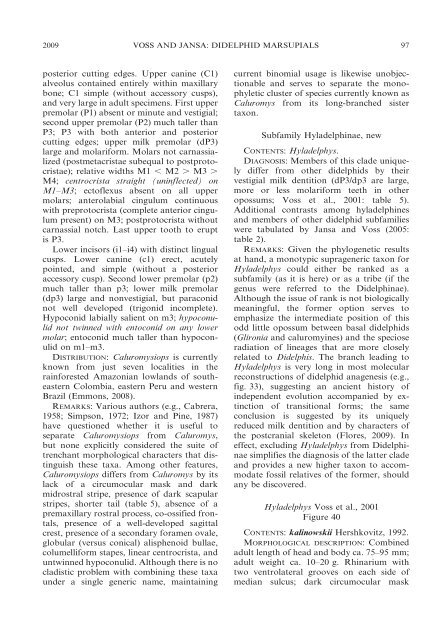phylogenetic relationships and classification of didelphid marsupials ...
phylogenetic relationships and classification of didelphid marsupials ...
phylogenetic relationships and classification of didelphid marsupials ...
You also want an ePaper? Increase the reach of your titles
YUMPU automatically turns print PDFs into web optimized ePapers that Google loves.
2009 VOSS AND JANSA: DIDELPHID MARSUPIALS 97<br />
posterior cutting edges. Upper canine (C1)<br />
alveolus contained entirely within maxillary<br />
bone; C1 simple (without accessory cusps),<br />
<strong>and</strong> very large in adult specimens. First upper<br />
premolar (P1) absent or minute <strong>and</strong> vestigial;<br />
second upper premolar (P2) much taller than<br />
P3; P3 with both anterior <strong>and</strong> posterior<br />
cutting edges; upper milk premolar (dP3)<br />
large <strong>and</strong> molariform. Molars not carnassialized<br />
(postmetacristae subequal to postprotocristae);<br />
relative widths M1 , M2 . M3 .<br />
M4; centrocrista straight (uninflected) on<br />
M1–M3; ect<strong>of</strong>lexus absent on all upper<br />
molars; anterolabial cingulum continuous<br />
with preprotocrista (complete anterior cingulum<br />
present) on M3; postprotocrista without<br />
carnassial notch. Last upper tooth to erupt<br />
is P3.<br />
Lower incisors (i1–i4) with distinct lingual<br />
cusps. Lower canine (c1) erect, acutely<br />
pointed, <strong>and</strong> simple (without a posterior<br />
accessory cusp). Second lower premolar (p2)<br />
much taller than p3; lower milk premolar<br />
(dp3) large <strong>and</strong> nonvestigial, but paraconid<br />
not well developed (trigonid incomplete).<br />
Hypoconid labially salient on m3; hypoconulid<br />
not twinned with entoconid on any lower<br />
molar; entoconid much taller than hypoconulid<br />
on m1–m3.<br />
DISTRIBUTION: Caluromysiops is currently<br />
known from just seven localities in the<br />
rainforested Amazonian lowl<strong>and</strong>s <strong>of</strong> southeastern<br />
Colombia, eastern Peru <strong>and</strong> western<br />
Brazil (Emmons, 2008).<br />
REMARKS: Various authors (e.g., Cabrera,<br />
1958; Simpson, 1972; Izor <strong>and</strong> Pine, 1987)<br />
have questioned whether it is useful to<br />
separate Caluromysiops from Caluromys,<br />
but none explicitly considered the suite <strong>of</strong><br />
trenchant morphological characters that distinguish<br />
these taxa. Among other features,<br />
Caluromysiops differs from Caluromys by its<br />
lack <strong>of</strong> a circumocular mask <strong>and</strong> dark<br />
midrostral stripe, presence <strong>of</strong> dark scapular<br />
stripes, shorter tail (table 5), absence <strong>of</strong> a<br />
premaxillary rostral process, co-ossified frontals,<br />
presence <strong>of</strong> a well-developed sagittal<br />
crest, presence <strong>of</strong> a secondary foramen ovale,<br />
globular (versus conical) alisphenoid bullae,<br />
columelliform stapes, linear centrocrista, <strong>and</strong><br />
untwinned hypoconulid. Although there is no<br />
cladistic problem with combining these taxa<br />
under a single generic name, maintaining<br />
current binomial usage is likewise unobjectionable<br />
<strong>and</strong> serves to separate the monophyletic<br />
cluster <strong>of</strong> species currently known as<br />
Caluromys from its long-branched sister<br />
taxon.<br />
Subfamily Hyladelphinae, new<br />
CONTENTS: Hyladelphys.<br />
DIAGNOSIS: Members <strong>of</strong> this clade uniquely<br />
differ from other <strong>didelphid</strong>s by their<br />
vestigial milk dentition (dP3/dp3 are large,<br />
more or less molariform teeth in other<br />
opossums; Voss et al., 2001: table 5).<br />
Additional contrasts among hyladelphines<br />
<strong>and</strong> members <strong>of</strong> other <strong>didelphid</strong> subfamilies<br />
were tabulated by Jansa <strong>and</strong> Voss (2005:<br />
table 2).<br />
REMARKS: Given the <strong>phylogenetic</strong> results<br />
at h<strong>and</strong>, a monotypic suprageneric taxon for<br />
Hyladelphys could either be ranked as a<br />
subfamily (as it is here) or as a tribe (if the<br />
genus were referred to the Didelphinae).<br />
Although the issue <strong>of</strong> rank is not biologically<br />
meaningful, the former option serves to<br />
emphasize the intermediate position <strong>of</strong> this<br />
odd little opossum between basal <strong>didelphid</strong>s<br />
(Glironia <strong>and</strong> caluromyines) <strong>and</strong> the speciose<br />
radiation <strong>of</strong> lineages that are more closely<br />
related to Didelphis. The branch leading to<br />
Hyladelphys is very long in most molecular<br />
reconstructions <strong>of</strong> <strong>didelphid</strong> anagenesis (e.g.,<br />
fig. 33), suggesting an ancient history <strong>of</strong><br />
independent evolution accompanied by extinction<br />
<strong>of</strong> transitional forms; the same<br />
conclusion is suggested by its uniquely<br />
reduced milk dentition <strong>and</strong> by characters <strong>of</strong><br />
the postcranial skeleton (Flores, 2009). In<br />
effect, excluding Hyladelphys from Didelphinae<br />
simplifies the diagnosis <strong>of</strong> the latter clade<br />
<strong>and</strong> provides a new higher taxon to accommodate<br />
fossil relatives <strong>of</strong> the former, should<br />
any be discovered.<br />
Hyladelphys Voss et al., 2001<br />
Figure 40<br />
CONTENTS: kalinowskii Hershkovitz, 1992.<br />
MORPHOLOGICAL DESCRIPTION: Combined<br />
adult length <strong>of</strong> head <strong>and</strong> body ca. 75–95 mm;<br />
adult weight ca. 10–20 g. Rhinarium with<br />
two ventrolateral grooves on each side <strong>of</strong><br />
median sulcus; dark circumocular mask

















